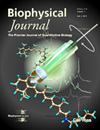Clustering DNA and RNA molecular dynamics ensembles via secondary structure.
IF 3.1
3区 生物学
Q2 BIOPHYSICS
引用次数: 0
Abstract
Macromolecular structure is central to biology. Yet, not all biomolecules have a well-defined fold. Intrinsically disordered regions are ubiquitous, conveying a versatility to function even in otherwise folded structures. For nucleic acids, entropic disorder is manifest in regions of incomplete base pairing (e.g., during transcription) and for long molecules (i.e., beyond the persistence length). To classify the resulting ensembles, we develop a method to cluster based on secondary structure, focusing specifically on DNA and RNA. The number of base pairs to reorganize furnishes a proper distance metric for structures of the same topology (e.g., without knots). This permits clustering of any type, from k-means to hierarchical to density-based methods. We demonstrate this by showing the broad distribution of secondary structure of a fragment of the M13 bacteriophage DNA and by revealing hidden order in a RNA Holliday junction. This clustering approach is connected to energy barriers from disrupting hybridization and recognizes structures that differ only by, e.g., internal reorientation as the same, compressing the vast free-energy landscape from entropic disorder.通过二级结构聚类DNA和RNA分子动力学集成。
大分子结构是生物学的核心。然而,并不是所有的生物分子都有明确的折叠。内在无序区域无处不在,即使在其他折叠结构中也具有功能的多功能性。对于核酸来说,熵失性表现在碱基配对不完全的区域(如转录期间)和长分子(即超过持续长度)。为了对结果集合进行分类,我们开发了一种基于二级结构的聚类方法,特别关注DNA和RNA。重组碱基对的数量为相同拓扑结构(例如,没有结)提供了适当的距离度量。这允许任何类型的聚类,从k-means到分层到基于密度的方法。我们通过展示M13噬菌体DNA片段的广泛二级结构分布和揭示RNA Holliday连接的隐藏顺序来证明这一点。这种聚类方法与干扰杂化的能量障碍相关联,并识别结构的不同,例如,内部重新定向相同,从熵无序中压缩巨大的自由能景观。
本文章由计算机程序翻译,如有差异,请以英文原文为准。
求助全文
约1分钟内获得全文
求助全文
来源期刊

Biophysical journal
生物-生物物理
CiteScore
6.10
自引率
5.90%
发文量
3090
审稿时长
2 months
期刊介绍:
BJ publishes original articles, letters, and perspectives on important problems in modern biophysics. The papers should be written so as to be of interest to a broad community of biophysicists. BJ welcomes experimental studies that employ quantitative physical approaches for the study of biological systems, including or spanning scales from molecule to whole organism. Experimental studies of a purely descriptive or phenomenological nature, with no theoretical or mechanistic underpinning, are not appropriate for publication in BJ. Theoretical studies should offer new insights into the understanding ofexperimental results or suggest new experimentally testable hypotheses. Articles reporting significant methodological or technological advances, which have potential to open new areas of biophysical investigation, are also suitable for publication in BJ. Papers describing improvements in accuracy or speed of existing methods or extra detail within methods described previously are not suitable for BJ.
 求助内容:
求助内容: 应助结果提醒方式:
应助结果提醒方式:


